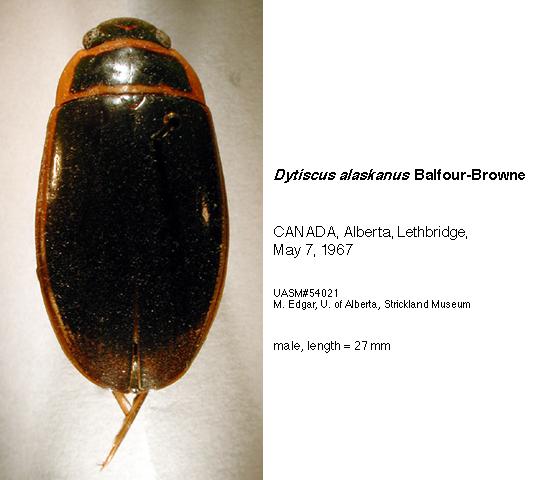Species Details
Dytiscus alaskanus
Freshwater Invertebrate Collection Read more about this collection »
Common NameBoreal water beetle
SeasonalityAdult population peak in late spring, declining into fall (Aiken and Wilkinson 1985).
IdentificationSmall to medium size (22.6 to 32.0 mm), elongate body (Larson et al. 2000). Brown-black to black - many with green appearance. Basal segments of antennae yellow, terminal segments darker. All pronotal margins bordered with yellow. Lateral border of elytra yellow, not reaching apex. Females with yellow striae and dark ridges. Yellow ventral surface, except brown-black metasternum, reddish metacoxa, margins of abdominal sterna narrowly black and thoracic sclerites with narrowly black margins. Dark basolateral marking on second and third sterna. Yellow or reddish legs.
Royal Alberta Museum page
Royal Alberta Museum page
Scientific Name
Dytiscus alaskanus
Common Name
Boreal water beetle
Seasonality
Adult population peak in late spring, declining into fall (Aiken and Wilkinson 1985).
Identification
Small to medium size (22.6 to 32.0 mm), elongate body (Larson et al. 2000). Brown-black to black - many with green appearance. Basal segments of antennae yellow, terminal segments darker. All pronotal margins…
Small to medium size (22.6 to 32.0 mm), elongate body (Larson et al. 2000). Brown-black to black - many with green appearance. Basal segments of antennae yellow, terminal segments darker. All pronotal margins bordered with yellow. Lateral border of elytra yellow, not reaching apex. Females with yellow striae and dark ridges. Yellow ventral surface, except brown-black metasternum, reddish metacoxa, margins of abdominal sterna narrowly black and thoracic sclerites with narrowly black margins. Dark basolateral marking on second and third sterna. Yellow or reddish legs.
Royal Alberta Museum page
Life History
Overwinter as adults in permanent waters (Larson et al. 2000). Early spring mating (Aiken 1992). Univoltine (Aiken and Wilkinson 1985). Strong swimmers, hind legs move together while swimming. Adults attracted to lights.
Conservation
No special status (IUCN 2002).
Diet Info
Predatory - active swimmers. Invertebrate and fish larvae prey. Suggestion that diet primarily composed of dead animal matter (Aiken and Leggett 1984). Predation rates highest at night (Aiken 1986).
Range
Royal Alberta Museum page
In Alberta this species has been recorded from most regions. This species ranges from Alaska to Newfoundland; known from all provinces and states along the USA-Canada border, as far south as Colorado (Larson et al.…
In Alberta this species has been recorded from most regions. This species ranges from Alaska to Newfoundland; known from all provinces and states along the USA-Canada border, as far south as Colorado (Larson et al. 2000, Partridge and Lauff 1999).
References
Title
2002 IUCN Red List of Threatened Species.
Publication Date
2002
Series Title
Ecology
Author
Aiken, R. B. and F. L. Leggett
Title
A Unique Collection of two Rhantus wallisi in the Body Cavity of a Female Dytiscus alaskanus (Coleoptera: Dytiscidae).
Publication Date
1984
Series Title
Entomological News
Volume
95
Pages
200-201
Author
Aiken, R. B. and C. W. Wilkinson
Title
Bionomics of Dytiscus alaskanus J. Balfour-Browne (Coleoptera: Dytiscidae) in a Central Alberta Lake.
Publication Date
1985
Series Title
Canadian Journal of Zoology
Volume
63
Pages
1316-1323
Author
Aiken, R. B.
Title
Diel activity of a boreal water beetle (Dytiscus alaskanus: Coleoptera; Dytiscidae) in the laboratory and field.
Publication Date
1986
Series Title
Freshwater Biology
Volume
16
Pages
155-159
Author
Patridge, V. L. and R. F. Lauff
Title
Expansion of the known range of two bog-dwelling beetles in Nova Scotia.
Publication Date
1999
Series Title
Northeastern Naturalist
Volume
6
Pages
31-34
Author
Larson, D. J.; Alaire, Y. and R. E. Roughley
Title
Predaceous Diving Beetles (Coleoptera: Dytiscidae) of the Nearctic Region, with emphasis on the fauna of Canada and Alaska.
Publication Date
2000
Pages
982
Author
Aiken, R. B.
Title
The Mating Behaviour of the Boreal Water Beetle, Dytiscus alaskanus (Coleoptera Dytiscidae).
Publication Date
1992
Series Title
Ethology, Ecology and Evolution
Volume
4
Pages
245-254
Specimen Information
There are 2 specimens of this Species.
IN4778 - Dytiscus alaskanus
Freshwater Invertebrate Collection
Place CollectedCanada: Alberta, Wood Buffalo National Park
Collected ByClassen, M.
Date Collected2005-06-05
IN4789 - Dytiscus alaskanus
Freshwater Invertebrate Collection
Place CollectedCanada: Alberta, Wood Buffalo National Park
Collected ByClassen, M.
Date Collected2005-05-20



